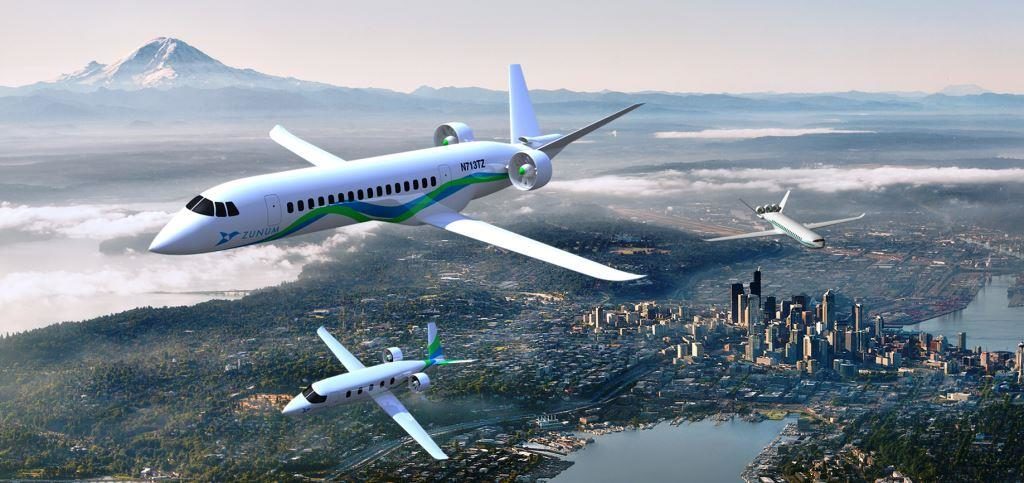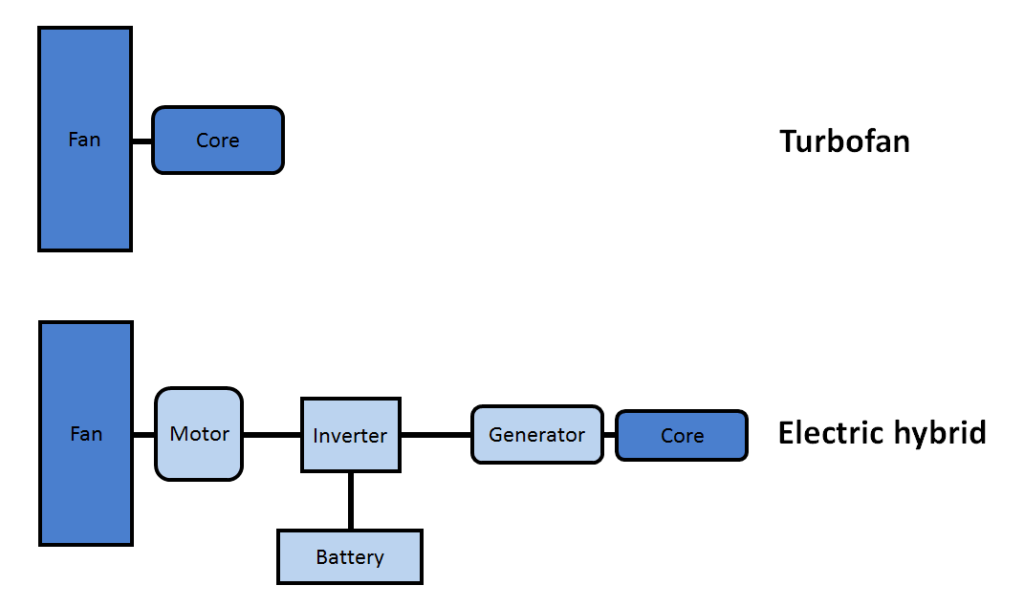Leeham News and Analysis
There's more to real news than a news release.
Bjorn’s Corner: Electric aircraft, Part 5
July 28, 2017, ©. Leeham Co: In the last Corner, we looked at the mass of the propulsion components for a regional airliner.
Now we complete the mass estimations for the complete hybrid electric system.
We do that for our aircraft project, which is a regional jet airliner with 50 seats. It’s using a hybrid propulsion system with four electric propulsors fed by a Gas turbine driven generator. The system uses a battery as a redundant energy source.

Figure 1. Zunum aero regional airliners and a NASA boundary layer ingestion airliner. Source: Zunum aero.
Weight of a hybrid chain, part 2
Last week we developed the masses for the propulsor units (fan+motor) shown in Figure 2. Now we continue with the other parts of the system. We start with the battery for redundancy during take-off and finish with the dimensioning of the generator and core.
By exploring the size of battery which is the minimum needed for redundancy, we also know what potential energy reserves we have for take-off and climb.
Minimum battery size
We use the battery as our redundant energy source, when the generator+core is not available. It shall only support finishing the take-off, leveling off and do a downwind with a direct landing. It shall support two such attempts to land, both in visual- and non-visual conditions.
We need to supply 7000kW during five minutes to finish the takeoff, 2,000kW during our leveling off and downwind for another five minutes and 1,500kW during our landing for an additional five minutes.
For two attempts, with a go-around after the first, we need 2* (7,000+2,000+1,500)* (5/60)=1,750kWh.
The problem is that at 170Wh per kg battery, this weigh us 10.3 tonnes of battery in the aircraft. For a jet aircraft category which has an empty weight of 14 tonnes, this is unacceptable. We will have to find another redundancy scheme or change our application for the hybrid concept.
Generator and core
Before we look at another solution to our jet regional airliner, let’s finish the generator and core sizing. We can see from the battery redundancy example that a battery as power boost during take-off is not practical. At least, not if we need to conserve battery energy to use for redundancy purposes.
After takeoff, during climb, we still need the battery as a backup for our generator+core. Should the generator or core fail, we need to be able to land the aircraft. If the 1,750kWh is sufficient we leave for now.
The generator and core then need to support our climb power, which is 9,332kW. The generator then weighs 1,170kg. The core would weigh 830kg. Together they weigh 2 tonnes.
Hybrid chain summary
A regional jet turbofan propulsion weighs 2*1,050kg=2,100kg. Our four propulsors weigh 2,800kg. To this we shall add generator with core of 2,000kg and any battery for redundancy. We are at 4.8 tonnes before we add the battery.
We can see that a hybrid electric propulsion system is not suited to jet speed applications. The required energy levels are too high and we cannot save any weight by using a battery as a redundancy component.
Change of strategy
The energy requirements for a regional jet aircraft are simply too high. We need to find feasible alternative concepts, where an electric hybrid solution fits better.
There are better candidates for an electric propulsion system. Turboprops for 50 passengers use a quarter of the power during a single engine take-off.
The ATR42-600 has a single engine take-off power at V2 of 2400shp or 1800kW. This is 26% of the regional jet for the same number of transported passengers.
We will talk about why the power is so much lower in the next Corner. We will also discuss a hybrid configuration for such an aircraft based on the experiences we have gathered so far.




Thanks Bjorn, this Corner is a very interesting read! Can’t wait next week!
Why do they have to be in series in each engine? Just use an enlarged electrical apu as a third engine to reduce the size needed for two large turboprops. The apu can be charged various ways (ram air turbine, on the ground, or through inverter/generator shown but linked to both turboprops.
The emergency capacity of a backup electric source working in conjunction with one working turboprop would net reduce turboprop size/cost/drag/wing load while improving safety and potentially economics in a 50 seater size. I would think with a braced wing design (ultra high aspect ratio) some interesting economics could be found/considered.
Hi Texl,
the idea was to use one APU (the core) driving a generator, this then electrically feeding two motors with fans or propellers.
But you then have a single point of failure. If the APU stops the airplane is without propulsion, not acceptable for a 50 seat aircraft.
I think a specific energy of 170 Wh/kg is a bit low – Tesla is using batteries with a specific energy of 265 Wh/kg in its Model S, and that was back in 2012. I don’t see why batteries in hybrid electric aircraft wouldn’t be at least as good as these.
Thanks, it takes the battery from 10.3 tonnes to 6.6. Still a magnitude to much.
Yes, it does help a bit but not too much, I admit. That’s why I agree with your conclusion that (hybrid-)electric aircraft will probably start at the smaller end of things, and then travel up to larger ones.
That being said, there have been studies on (hybrid-)electric aircraft, done by people at Boeing as part of NASA projects, that have predictions as high as 750 Wh/kg in the 2030s timeline – see the Boeing SUGAR Volt final report for example. Researchers like Mark Moore, who is working on the next NASA X-Plane, the X-57 Maxwell, predicts a specific energy of 400 Wh/kg, by 2020, which might be a bit optimistic in my opinion, but I think battery specific energy will get there eventually. These values change the equation.
Part of the benefit, these studies argue, come from not only replacing the “traditional” propulsion system with a (hybrid-)electric one, but also from overall system-level change. Designers have to rethink the problem. There is a lot that can be done at system-level, for example: better propulsion system/ airframe integration with boundary layer ingestion and/or distributed propulsion.
So the bigger picture is not that simple, but I remain optimistic.
To add to this, you can already see very small aircraft going fully electric – the most prominent example being the Airbus E-fan, which Airbus intends to develop as a training/ general aviation aircraft. Other include the Pipstrel Taurus electro, ElectraFlyer C (powered gliders), Volta Voltare, Yuneec E430.
Hi NeBaNi,
first, the use of advanced techniques like laminar flow and boundary layer ingestion was discusses in Part 3. But we are talking about improvements of drag in the order of 10-20%. While this helps we are magnitudes from where we need to be with our regional jet. We will have a better chance with a lower speed turboprop.
Re batteries, I have found that Airbus Vahana project assumes 200Wh/kg for the most advanced battery pack available today and that it will be at 300Wh/kg by 2025. I will use these values from now on, it takes our 1750kWh battery systems down to 5.8 tonnes, about 7.8 times the weight of a second turbofan which would also gives us hours of redundancy instead of minutes.
Let’s see what happens with the turboprop example. Regional jet one can forget.
Why not supply power to the engines with a electrified rail on the runway for getting up to takeoff speed? As well, a linear tractor motor built into the runway could assist the engines by pushing the wheels ….. similar to carrier assisted catapults but not as severe.
I agree with the commentator above. To reduce carbon emissions by aircraft a radical approach needs to be taken in thinking. Four points:
If using batteries isn’t there a reduction in engine weight?
Why is it not possible to recharge batteries on the descent to landing?
On a similar vein, if current engines are used at full power only at take-off why not split any reduction in engine size with the ability to charge the batteries during the flight?
The space shuttle had no power on landing, why shouldn’t commercial aircraft more closely follow this approach?
My other comment is that region LCC spend as little as 30 minutes on the ground between flights. Is this time enough to recharge batteries?
I always find you analyses very interesting and informative. However, I find you a bit conservative sometimes. In this analysis you assume everything else is equal. It is not. One has to include secondary effects.
With that said, batteries won’t be an efficient energy carrier for weight sensitive applications anytime soon.
But what about a helicopter that’s only supposed to fly between an airport and the corresponding city center?